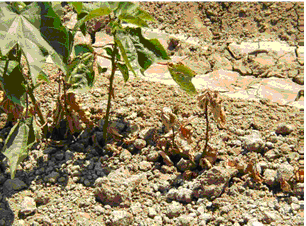Welcome to UC Cotton Research & Information
Today's Tip
Insecticide spray coverage and efficacy assessment
In California, cotton aphids and silverleaf whiteflies pose a significant economic threat by producing sticky cotton. Insecticide sprays are the primary means of controlling their populations. However, regulations have restricted the use of a number of insecticides (including chlorpyrifos), limiting available options. Both aerial and ground application methods are commonly used for applying insecticides in cotton. However, aerial applications become relied upon much more as the season progresses, which is when these pests are most problematic. The efficacy of the insecticide likely depends on the coverage, which in turn depends on the method of application.
Here we provide an update on an ongoing project that is evaluating insecticide application coverage and efficacy against cotton aphids and silverleaf whiteflies.
What is FOV Race 4?
Fusarium oxysporum f. sp. vasinfectum (or “FOV”) is a soil-inhabiting fungus that causes a vascular wilt disease in susceptible cotton varieties. It has been widely recognized in the San Joaquin Valley since the 1950’s. Historically, Fusarium wilt in cotton produced visible symptoms and caused economic damage only in susceptible varieties in combination with significant populations of the root knot nematode (Meloidogyne incognita). Fusarium wilts usually seen in these prior recognized cases were caused by race 1 or race 2 of FOV. In recent years, however, several localized occurrences of FOV infections with moderate to severe plant damage have been confirmed in the absence of nematode populations.

In these cases, the disease was caused by race 4 FOV. Evaluations in 2003 indicated that all widely-grown commercial Pima varieties tested were more seriously damaged than tested Acala or non-Acala Upland varieties. Field trials also indicated good levels of resistance to race 4 FOV in some experimental Pima varieties. It is significant, however, that many Upland/Acala varieties field-tested under high race 4 inoculum loads in 2003 were also infected, albeit with fewer symptoms and less damage than in most Pima varieties.
WHAT'S NEW?
Yield & Quality
Subscribe to our Mailing List!
Subscribe to mailing list: cottoninfo










